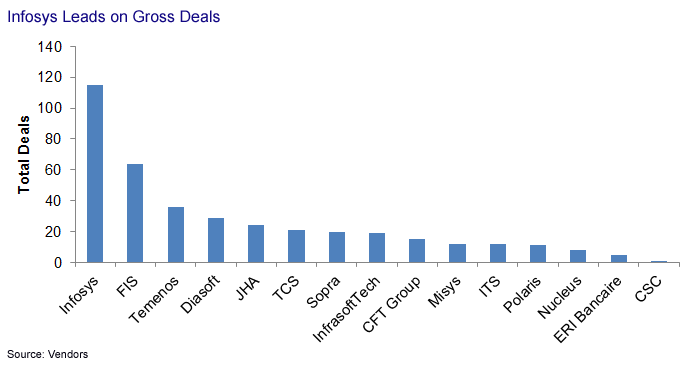The Big Leagues 2013: Core Platform Sales Ranking
Abstract
Moving into 2014, the definition of core banking continues to evolve at varying speeds around the world.
Core systems were sold in over 70 countries in 2013, down from more than 80 in 2012. Total deals globally totaled more than 360 on Celent’s Big Leagues deal score, down from 445 in 2011-12.
In the report The Big Leagues 2013: Core Platform Sales Ranking, Celent has developed a methodology to rank the core banking vendors on their deals between July 1, 2012 and June 30, 2013. The Celent Big Leagues Table uses a weighted score designed to assess the value of deals won, rather than merely the number of deals. Celent introduced the Big Leagues Table to compare how various core banking vendors performed across the world.
For some, core means everything that is central to the bank; mobile banking and channels are quickly moving in this direction. For others, core is a tight bundling of essential record-keeping and deposits that tries to be as small as possible. The latter is an example of what many banks have done to sidestep the limitations of an aging platform. The branch is no longer the center of the banking universe, and digital (including changing customer demand) is changing the branch-centric design and product-centric business model that has dominated banking
For Celent, the definition of core has historically been retail and wholesale deposits and lending, together with the system of record for customer information. Celent sees a shift in the way vendors have taken on the challenge of transformations. This has at once made core deals difficult to track yet easier to undertake. Modularization and componentization aren’t new, but these key concepts are opening up possibilities for core.

“Celent is bullish about the core market,” says Dan Latimore, Senior Vice President with Celent’s Banking Group and coauthor of the report. “Standardization initiatives are gaining momentum, and as IT development evolves toward simplicity and modularity, core adoption will become easier to justify.”
“The cycle time for new channels and products will continue to shorten,” adds Stephen Greer, Analyst with Celent’s Banking Group and coauthor of the report. “As complexity grows, vendors will undoubtedly be at the forefront of innovation, with core banking deals not far behind.”
This report examines core banking sales based on two key components: geography and vendor. The report delves into global, regional, and vendor-specific trends.

